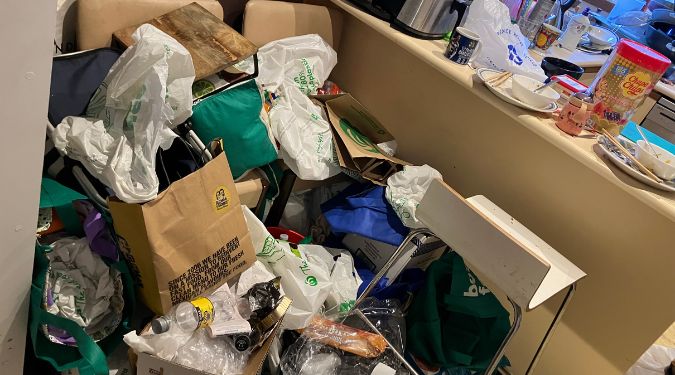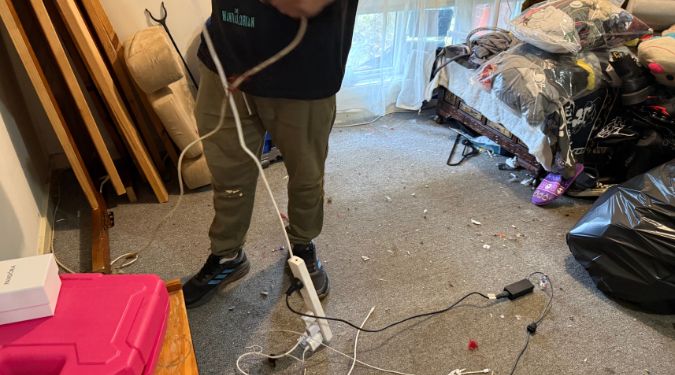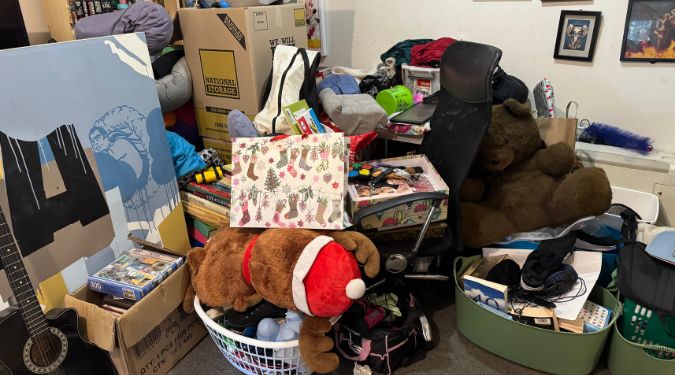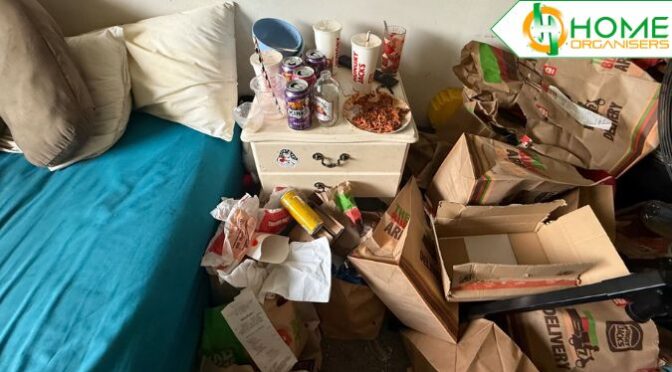When people think of clutter, they often picture messy cupboards, clothes on the floor, or stacks of paperwork. But clutter is more than mess. For many NDIS participants, clutter is a serious safety issue. It can affect their physical health, emotional well-being, daily living, and even their financial stability.
In this blog, we’ll explore why clutter matters so much—especially for NDIS support teams. We’ll look at clutter from many angles: health, mental and emotional wellbeing, family dynamics, independence, productivity, safety, and even how it can affect long-term outcomes for participants.
We’ll also explain what NDIS support workers, support coordinators, and plan managers need to know about clutter—and how decluttering support fits into a well-rounded NDIS plan focused on home safety NDIS participants deserve.
Let’s break it down simply and clearly.
Clutter Is a Health Hazard
A cluttered home can quickly become a dangerous one—especially for people living with disability.
Falls and injuries:
Items on the floor can cause trips or falls. Narrow walkways and stacked objects make moving around harder. If someone uses a walker, wheelchair, or has poor balance, clutter can be life-threatening.
Blocked access to care:
In an emergency, first responders need clear access. Paramedics might not be able to reach the person if the doorway is blocked or the room is filled. This can delay care during a crisis.
Fire hazards:
Too much clutter—especially paper, fabric, or rubbish—increases the risk of house fires. It can also block exits, making it hard to escape if a fire breaks out.
Hygiene risks:
Clutter can attract pests, mould, or dust. This can lead to breathing problems, infections, and worsening health—especially for people with asthma, weakened immune systems, or chronic illnesses.
All of these are clear safeguarding risks. They turn regular homes into unsafe environments. Supporting home safety NDIS participants requires means identifying and addressing these hazards early.
Clutter Impacts Mental Health
A cluttered home can lead to a cluttered mind. Many NDIS participants already face challenges with anxiety, depression, or other mental health conditions. Clutter can make these feelings worse.
Overwhelm:
Living in a space that feels chaotic can cause constant stress. Every item out of place becomes a reminder of what hasn’t been done. It can feel impossible to relax.
Decision fatigue:
Too much stuff can make simple decisions hard. What should I wear? Where’s that document? When choices pile up, it becomes easier to shut down completely.
Low self-worth:
Cluttered homes can make people feel ashamed, embarrassed, or like they’re failing. This can lower confidence and make it harder to ask for help.
Social withdrawal:
People living with clutter often avoid visitors. They might stop inviting family, friends, or even support workers into their home. This leads to isolation—another safeguarding risk that support teams must take seriously.
Clutter Affects Emotional Wellbeing
Clutter doesn’t just impact how a space looks—it changes how people feel inside their own homes.
A sense of chaos:
Our environment affects our emotions. Calm spaces help people feel calm. Messy spaces create stress, anger, or sadness—even if it’s not obvious at first.
Loss of control:
For NDIS participants trying to feel independent and empowered, clutter can feel like a reminder that life is out of control. It can create a cycle: clutter leads to stress, which leads to more clutter.
Emotional attachments:
Many people have strong feelings tied to their belongings. It’s not always easy to let go. But when emotions keep people stuck in unsafe environments, support is needed.
This is where home safety NDIS services come in. Supporting people to feel in control of their space helps restore emotional balance and improves well-being.

Clutter Can Strain Family Relationships
For participants living with family or carers, clutter often becomes a source of tension.
Disagreements and frustration:
Family members may not agree on what should stay or go. They might get angry, upset, or feel ignored when clutter builds up.
Blame and guilt:
Loved ones might feel responsible, even if they’re not. Participants might feel like a burden. These emotions can damage trust and communication.
Caregiver stress:
If carers are cleaning or managing clutter every day, it can lead to burnout. They may have less time or energy to support the participant in other ways.
Supporting families also means addressing clutter as one of the safeguarding risks that can fracture important relationships.
Clutter Makes It Harder to Live Independently
For many NDIS participants, the goal is to live independently or build life skills. Clutter gets in the way.
Daily tasks become harder:
Cooking, cleaning, dressing, and taking medications—these all become more difficult when spaces are messy or unsafe.
Loss of routine:
Clutter can cause confusion and disorganisation. Important items go missing. Bills get lost. Appointments are forgotten. This makes routines harder to maintain.
Reduced capacity building:
When a participant is focused on surviving the mess, they’re not focused on growing new skills, setting goals, or enjoying life.
In these situations, home safety NDIS plans must address the physical environment to help participants thrive.

Clutter Impacts Productivity
When your space is messy, it’s hard to focus. This applies not only to work or study, but also to everyday tasks.
Harder to complete jobs:
From writing a list to paying bills, clutter makes it harder to start and finish tasks. It slows people down and creates distractions.
More effort, less result:
NDIS participants may spend lots of time looking for things, clearing space, or fixing problems caused by clutter. This wastes energy that could be used on more meaningful activities.
Missed opportunities:
Clutter can stop someone from working, volunteering, or learning—because the environment isn’t ready for it. That’s why tackling clutter is about more than cleaning—it’s part of reducing safeguarding risks and boosting independence.
Clutter Affects Mood and Wellbeing
We all feel better in spaces that are clean, calm, and easy to manage. A tidy environment supports positive moods and improves quality of life.
Better sleep:
Studies show that people sleep better in clean, tidy bedrooms. Clutter can cause anxiety at night, making rest harder.
Improved motivation:
When a room feels under control, people feel more in control of their lives. They’re more likely to try new things and get involved in their own care.
Positive self-image:
Living in a well-kept home builds pride and dignity—two things every person deserves to feel. This is core to any home safety NDIS support strategy.
Clutter Can Affect Wealth and Finances
It might not seem obvious, but clutter can cost money.
Lost items = lost dollars:
When things go missing, people often re-buy them. From tools to clothes to food that spoils, the cost adds up.
Late bills and missed payments:
Clutter can hide important documents. Missing bills can lead to late fees, debt, or utility disconnections.
Blocked access to services:
If a home is too cluttered, services like cleaners, support workers, or tradespeople may refuse to enter. This can delay maintenance and increase long-term costs.
These are hidden safeguarding risks that can push vulnerable people into even more stress.

Decluttering Is a Safeguarding Issue
In simple terms, “safeguarding” means protecting someone’s health, well-being, and rights. For NDIS participants, this includes physical safety, mental wellness, and the ability to live a good life.
When clutter creates danger, reduces quality of life, or limits independence, it becomes a safeguarding risk.
Support teams—whether you’re a support worker, support coordinator, or plan manager—have a duty of care. That means looking beyond the surface and recognising when clutter is becoming a risk.
It’s not just about tidying up—it’s about supporting a person’s ability to live with dignity and safety, and preventing them from staying stuck in unsafe environments.
Decluttering Support and the NDIS
The good news is that NDIS participants can often receive support to declutter and organise their homes.
Depending on a participant’s goals and needs, decluttering services may fall under categories like:
- Daily Living (Core Supports)
- Improved Living Arrangements (Capacity Building)
- Home Modifications or Assistive Technology
- Support Coordination
- Psychosocial Recovery Coaching
A skilled home organiser works with the participant and their support team to understand needs, create goals, and deliver decluttering help in a respectful, person-centred way.
At Home Organisers, we work closely with NDIS plans and providers to ensure our services align with participant outcomes, values, and goals—while always prioritising home safety NDIS participants can count on.
What Support Teams Can Do
If you work with NDIS participants, here are some practical steps to take:
- Identify early signs: Notice when clutter is starting to interfere with daily tasks or safety.
- Discuss with empathy: Approach the topic gently and without judgment.
- Refer to specialists: Bring in experienced home organisers who understand NDIS and work respectfully with participants.
- Link to goals: Show how decluttering supports the participant’s life goals, health, and independence.
- Plan for the long term: Consider follow-up support or regular maintenance to prevent clutter from returning.
This is part of managing safeguarding risks and making sure no one has to live in unsafe environments.
Final Thoughts: A Safe Home Is a Human Right
Everyone deserves to feel safe, proud, and comfortable in their own home.
For NDIS participants, clutter is not just a personal issue—it’s a shared responsibility. When homes become unsafe environments, unmanageable, or overwhelming, it affects every part of life: from health to happiness to financial well-being.
Decluttering is more than cleaning—it’s an act of care. It protects dignity. It supports independence. And for NDIS support teams, it’s a powerful way to fulfil your duty of care.
Need help making a home safer and more manageable for an NDIS participant?
Call us on 03 8583 9103
Email nancy@homeorganisers.com.au Or visit homeorganisers.com.au to get started today.
Case Study 1: “Sandra’s Story – Reclaiming Her Home and Confidence”
Background:
Sandra is a 58-year-old woman living with multiple chronic health conditions, including arthritis and anxiety. As an NDIS participant, she receives daily support through her plan, but her home environment had become a growing concern. Over time, clutter had taken over every room. There were boxes of paperwork from the past 15 years, clothing piles on every chair, and barely any walking space in the hallway or kitchen.
The Challenge:
Sandra’s support coordinator flagged the home as an unsafe environment. She had already experienced two falls in the past year, tripping over misplaced items in the hallway. Emergency services had difficulty accessing her bedroom during a recent asthma episode, prompting concerns about safeguarding risks. Sandra also reported feeling ashamed, anxious, and overwhelmed—often cancelling support workers due to embarrassment.
The Solution:
Home Organisers were brought in through her plan as part of home safety NDIS support. Our team approached Sandra with compassion and no judgment. Over six weeks, we worked together to declutter key areas: the hallway, kitchen, bathroom, and bedroom.
We focused on:
- Removing trip hazards
- Organising essential items within easy reach
- Clearing pathways for emergency access
- Establishing calming, clutter-free zones
Each step was taken slowly, with Sandra involved in every decision. Emotional attachment to items was handled gently, and nothing was thrown away without her consent.
The Outcome:
Sandra now has a clean, functional home that supports her health, safety, and independence. She reports better sleep, improved mood, and no longer cancels support visits. Her NDIS team has noticed she’s more confident, communicative, and engaged in her care.
Sandra’s space is no longer a safeguarding risk—it’s a source of pride.
Case Study 2: “David’s Home Makeover – Decluttering to Prevent a Crisis”
Background:
David is a 42-year-old man with psychosocial disability living in community housing. He’s an NDIS participant who receives daily living support. His support workers noticed David’s flat was becoming increasingly difficult to navigate. The living room was filled with old electronics, broken furniture, bags of unopened mail, and takeaway containers. He had started sleeping on the couch because his bedroom was inaccessible.
The Challenge:
David’s clutter had reached a point where it was interfering with all aspects of his daily life. He had stopped cooking, was wearing unwashed clothes, and hadn’t let a friend or family member visit in over a year. The apartment posed serious safeguarding risks—fire hazards, blocked exits, and major hygiene issues. His support workers were concerned the clutter could lead to service refusal or eviction.
The situation was escalating toward crisis, and the apartment was flagged as an unsafe environment.
The Solution:
David’s support coordinator updated his plan to include a structured decluttering program under home safety NDIS. Home Organisers met with David and his psychosocial recovery coach to understand his triggers, goals, and boundaries.
Our approach included:
- Starting with high-priority zones (kitchen, bathroom, bedroom)
- Using visual reminders to reduce overwhelm
- Creating “safe zones” David could maintain independently
- Educating him on how to identify potential safeguarding risks
We ensured the support was trauma-informed, gradual, and built around David’s own sense of control.
The Outcome:
In 10 sessions, David’s home transformed. He began cooking simple meals again, welcomed his sister over for the first time in years, and started attending community art classes. His mental health improved, his tenancy was no longer at risk, and his support team reported fewer incidents of crisis intervention.
Thanks to coordinated care and decluttering, David now lives in a space that’s clean, dignified, and free from unsafe environments.
FAQ for NDIS Support Teams: Dealing with Clutter as a Safety Issue
- 1. How do I know if clutter is putting my loved one at risk at home?
If everyday items are blocking walkways, causing trips, or making it hard to cook, clean, or access care—these are clear signs the clutter may be turning the home into an unsafe environment. We can assess the situation gently and help make it safe again.
- 2. Can Home Organisers help with hoarding-related clutter for NDIS participants?
Yes. We work with compassion and without judgment. Hoarding is complex and often tied to trauma or mental health. Our team understands this and works with clients at their pace, always respecting their dignity.
- 3. Is decluttering something that can be included in an NDIS plan?
Absolutely. Many NDIS plans include decluttering under Core Supports or Capacity Building, especially when it relates to home safety, wellbeing, and independence.
- 4. What if my client is embarrassed about the state of their home?
That’s completely normal—and we approach every job with sensitivity. Our organisers are trained to support without judgment. We’re here to help, not shame.
- 5. How does decluttering support mental health and emotional wellbeing?
A clean, calm space can reduce anxiety, improve mood, and restore a sense of control. Decluttering often helps people feel proud of their space again, which lifts self-esteem and confidence.
- 6. Can a cluttered home prevent support workers from doing their job?
Yes, in some cases. Clutter can block access to beds, bathrooms, or equipment. If it’s hard for workers to move safely, they may be unable to provide proper care—making it a serious safeguarding risk.
- 7. What happens during a decluttering session with Home Organisers?
We start with a conversation—no pressure, no judgment. We help identify what’s needed, sort items together, and create a plan to make the space safer, more functional, and easier to manage long term.
- 8. How often should decluttering be done for NDIS participants?
This depends on each person’s situation. Some benefit from one-off support, while others need regular visits to maintain home safety NDIS participants rely on. We tailor support to each individual.
- 9. What are the emotional signs that clutter has become too much to handle alone?
If someone feels overwhelmed, avoids parts of their home, stops inviting people over, or feels anxious about their surroundings—these are strong signs it’s time to get support.
- 10. Why is it so hard for some people to let go of clutter—even when it’s clearly unsafe?
Letting go of belongings isn’t just about stuff—it’s about memories, control, loss, or fear of needing something later. For many NDIS participants, clutter is linked to deeper emotional needs. That’s why respectful, person-centred decluttering support matters. It’s not just cleaning—it’s healing, too.


